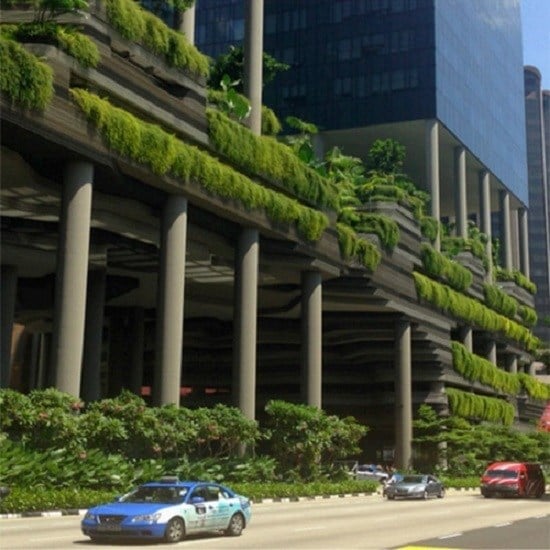Geoengineering in the Anthropocene through Regenerative Urbanism
Abstract
:1. Introduction
1.1. The Anthropocene
1.2. High Level Governance of Anthropogenic Climate Change
1.3. Geoengineering: The Silver Bullet?
2. The Potential of Cities
2.1. The Phenomenal Growth of Cities
- cities and urban areas yet to be built;
- urban upgrades in slums;
- urban renewal in growing developed cities;
- urban retrofits of existing areas [40].
2.2. Urban Geoengineering and Green Urbanism
2.3. Three Horizons of Urban Sustainability Performance
2.4. The Three Urban Horizons in Relation to Decarbonizing Cities
- Structures that reduce energy demand and therefore reduce GHG emissions,
- Operational efficiency measures that improve energy efficiency,
- Renewable energy sources to displace GHG emitting fuels,
- CDR techniques utilizing third way technology to actively remove GHG from the atmosphere (urban geoengineering).
- Urban growth boundaries for compact city footprints to reduce urban encroachment upon adjoining carbon sinks such as forested land, e.g., Portland, Oregon’s urban growth boundary, a policy which has been in place since the 1970s [84];
- Energy efficient appliances;
- Transport technology efficiencies;
- Passive building design [91].
- Carbon negative construction such as:
- ○
- Carbon absorbing cement that takes CO2 from industrial waste and incorporates it into cement (e.g., Solidia cement) and carbon negative plastics that capture CO2 from the air (e.g., Newlight Technologies AirCarbon) [29]
- ○
- ○
- Carbon negative landscaping using Serpentine rocks that, when crushed, absorb CO2 from the air [29];
- Carbon negative waste streams, such as biochar from combustible timber waste (e.g., from sources such as biogenic building material offcuts, forestry and agricultural waste) [29];
- Carbon negative industrial products, such as the industrial manufacturing of carbon nano fibres for many functions and carbon fibre replacing steel [29];
3. Regenerative Cities
- Create more energy than it needed.
- Use water sparingly with full recycling so it would not need to draw upon an external supply and enable regeneration of ground water systems and rivers.
- Regenerate natural systems in degraded areas to support biodiversity of a complexity similar to the pre-settlement bioregion’s natural capacity.
- Reduce the scale and length of centralized infrastructure for energy, water and storm water infrastructure, and the embodied and operational energy required for this infrastructure.
- West Village, University of California (UC), Davis—the largest net zero carbon development in the USA—created by UC Davis with the local government [108];
- White Gum Valley or WGV (Perth, Australia)—a net positive energy precinct based on solar and batteries, with zero waste and high water goals—created by the WA Government, Fremantle Council and Curtin University;
- The Peterborough Carbon Challenge (marketed as “Vista”)—in 2012 the largest zero carbon development in the UK—led by the UK Government as a “Carbon Challenge” demonstration site and delivered through a public private partnership [109];
- Both Hammarby Sjöstad and the Royal Stockholm Seaport—created by the Swedish and Stockholm governments—are regenerative in energy and water as well as exhibiting extremely high recycling waste rates (enabled by automated vacuum waste collection streams);
- Vauban, Freiburg in Germany—with its net positive renewable energy system, dubbed the “greenest city in Europe”—led by a not-for-profit civic group with facilitation from the local government [110].
4. Conclusions
Acknowledgments
Author Contributions
Conflicts of Interest
Abbreviations
| CDR | Carbon Dioxide Removal |
| IPCC | International Panel on Climate Change |
| GHG | Green House Gas |
| GU | Green Urbanism |
| RU | Regenerative Urbanism |
| SRM | Solar Radiation Management |
References
- Crutzen, P.J. Geology of mankind. Nature 2002, 415. [Google Scholar] [CrossRef] [PubMed]
- Steffen, W.; Persson, Å.; Deutsch, L.; Zalasiewicz, J.; Williams, M.; Crumley, C.; Crutzen, P.; Folke, C.; Gordon, L.; Molina, M.; et al. The Anthropocene: From Global Change to Planetary Stewardship. Ambio 2011, 40, 739–761. [Google Scholar] [CrossRef] [PubMed]
- Waters, C.N.; Zalasiewicz, J.; Summerhayes, C.; Barnosky, A.D.; Poirier, C.; Gałuszka, A.; Cearreta, A.; Edgeworth, M.; Ellis, E.C.; Ellis, M.; et al. The Anthropocene is functionally and stratigraphically distinct from the Holocene. Science 2016, 351, 137–147. [Google Scholar] [CrossRef] [PubMed]
- Intergovernmental Panel on Climate Change (IPCC). Climate Change 2014: Mitigation of Climate Change. Contribution of Working Group III to the Fifth Assessment Report of the Intergovernmental Panel on Climate Change; Edenhofer, O., Pichs-Madruga, R., Sokona, Y., Farahani, E., Kadner, S., Seyboth, K., Adler, A., Baum, I., Bruuner, S., Eickemeier, P., et al., Eds.; Cambridge University Press: Cambridge, UK; New York, NY, USA, 2014; p. 1454. [Google Scholar]
- Fink, J.H. Geoengineering Cities to Stabilise Climate. Proc. Inst. Civil Eng. Eng. Sustain. 2013, 166, 242–248. [Google Scholar] [CrossRef]
- United Nations Department of Economic and Social Affairs Population Division. World Urbanization Prospects: The 2014 Revision, Highlights (ST/ESA/SER.A/352); United Nations: New York, NY, USA, 2014. Available online: http://esa.un.org/unpd/wup/Highlights/WUP2014-Highlights.pdf (accessed on 17 October 2016).
- World Commission on Environment and Development. Our Common Future; Oxford University Press: New York, NY, USA, 1987. [Google Scholar]
- Newman, P.; Kenworthy, J. Cities and Automobile Dependence: An International Sourcebook; Gower Publishing Company: Aldershot, UK, 1989. [Google Scholar]
- Intergovernmental Panel on Climate Change (IPCC). Summary for Policy Makers. In Climate Chang 2014: Impacts, Adapt Vulnerability. Contribution of Work Group II to the Fifth Assessment Report of the Intergovernmental Panel on Climate Change; Cambridge University Press: Cambridge, UK; New York, NY, USA, 2014; pp. 1–32. [Google Scholar]
- Stern, N. The stern review on the economic effects of climate change. Popul. Dev. Rev. 2006, 32, 793–798. [Google Scholar]
- United Nations Framework Convention on Climate Change (UNFCCC). Clean Development Mechanism Methodology Booklet; UNFCCC: New York, NY, USA, 2013. [Google Scholar]
- Lynch, A.J.; Andreason, S.; Eisenman, T.; Robinson, J.; Steif, K.; Birch, E.L. Sustainable Urban Development Indicators for the United States; Penn Institute for Urban Research: Philadelphia, PA, USA, 2011. [Google Scholar]
- United Nations. Adoption of the Paris Agreement. Available online: http://unfccc.int/resource/docs/2015/cop21/eng/l09r01.pdf (accessed on 17 October 2016).
- Intergovernmental Panel on Climate Change (IPCC). Working Group III—Mitigation of Climate Change; IPCC: Geneva, Switzerland, 2014. [Google Scholar]
- United Nations. Climate Action Now, Summary for Policymakers 2015; United Nations: New York, NY, USA, 2015. [Google Scholar]
- Geels, F.W. Technological transitions as evolutionary reconfiguration processes: A multi-level perspective and a case-study. Res. Policy 2002, 31, 1257–1274. [Google Scholar] [CrossRef]
- Geels, F.W. Ontologies, socio-technical transitions (to sustainability), and the multi-level perspective. Res. Policy 2010, 39, 495–510. [Google Scholar] [CrossRef]
- Smith, A.; Voß, J.P.; Grin, J. Innovation studies and sustainability transitions: The allure of the multi-level perspective and its challenges. Res. Policy 2010, 39, 435–448. [Google Scholar] [CrossRef]
- Girardet, H. Creating Regenerative Cities; Routledge: Abingdon, Oxon, 2015. [Google Scholar]
- Droege, P. Urban Energy Transition: An Introduction; Elsevier Science: New York, NY, USA, 2008; p. 655. [Google Scholar]
- Newman, P.; Kenworthy, J. Sustainability and Cities: Overcoming Automobile Dependence; Island Press: Washington, DC, USA, 1999. [Google Scholar]
- Geels, F.W. The multi-level perspective on sustainability transitions: Responses to seven criticisms. Environ. Innov. Soc. Transit. 2011, 1, 24–40. [Google Scholar] [CrossRef]
- Australian Public Service Commission. Tackling Wicked Problems: A Public Policy Perspective; Commonwealth of Australia: Canberra, Australia, 2007; p. 46.
- Newton, P.W. Liveable and Sustainable? Socio-Technical Challenges for Twenty-First-Century Cities. J. Urban Technol. 2012, 19, 81–102. [Google Scholar] [CrossRef]
- House of Commons Science and Technology Committee. The Regulation of Geoengineering; House of Commons Science and Technology Committee: London, UK, 2010. [Google Scholar]
- National Academy of Science. Climate Intervention: Reflecting Sunlight to Cool Earth; National Academies Press: Washington, DC, USA, 2015. [Google Scholar]
- University of Oxford. PRESS RELEASE: “Oxford Principles” Provide a Code of Conduct for Geoengineering Research; University of Oxford: Oxford, UK, 2011. [Google Scholar]
- National Academy of Sciences. Climate Intervention: Carbon Dioxide Removal and Reliable Sequestration; National Academies Press: Washington, DC, USA, 2015. [Google Scholar]
- Flannery, T. Atmosphere of Hope: Solutions to the Climate Crisis; Penguin Books Limited: London, UK, 2015. [Google Scholar]
- Norgaard, R. Escaping Economism, Escaping the Econocene. In Economy of Sufficiency; Schniedewind, U., Santarius, T., Humburg, A., Eds.; Wuppertal Institute for Climate, Environment and Energy: Wuppertal, Germany, 2013; pp. 44–53. [Google Scholar]
- United Nations Population Fund (UNFPA). The State of the world Population 2007: Unleashing the Potential of Urban Growth; UNFPA: New York, NY, USA, 2007. [Google Scholar]
- Kenworthy, J. Total daily mobility patterns and their implications for forty-three global cities in 1995 and 2005. World Transp. Policy Pract. 2014, 20, 41–55. [Google Scholar]
- Kenworthy, J.; Laube, F. Millenium Cities Database for Sustainable Transport; International Association for Public Transport: Brussels, Belgium, 2001. [Google Scholar]
- Gardner, H.; Newman, P. Reducing the Materials and Resource Intensity of the Built form in the Perth and Peel Regions; Curtin University Sustainability Policy (CUSP) Institute: Perth, Australia, 2013. [Google Scholar]
- Newman, P.; Kenworthy, J. The End of Automobile Dependence: How Cities are Moving Beyond Car-Based Planning; Island Press: Washington, DC, USA, 2015. [Google Scholar]
- United Nations. World Urbanization Prospects 2014: Highlights; United Nations: New York, NY, USA, 2014. [Google Scholar]
- UN Habitat. Urbanization and Development Emerging Futures; World Cities Report 2016; United Nations Human Settlements Programme: Nairobi, Kenya, 2016. [Google Scholar]
- Krockenberger, M. Population Growth in Australia; The Australia Institute: Canberra, Australia, 2015. [Google Scholar]
- Newton, P.; Newman, P.; Glackin, S.; Trubka, R. Greening the Greyfields: Unlocking the Redevelopment Potential of the Middle Suburbs in Australian Cities. World Acad. Sci. Eng. Technol. 2012, 71, 658–677. [Google Scholar]
- Delhagen, E.; McKearnan, S.; Nicholas, S.; Hamilton, B.; Neme, C.; Wang, E. Scaling up Building Energy Retrofitting in US Cities—A Resource Guide for Local Leaders; Living Cities: Washington, DC, USA; Institute for Sustainable Communities: Montpelier, VT, USA, 2009. [Google Scholar]
- United Nations. A New Global Partnership: Eradicate Poverty and Transform Economies through Sustainable Development: The Report of the High-Level Panel of Eminent Persons on the Post-2015 Development Agenda; United Nations: New York, NY, USA, 2013. [Google Scholar]
- Newman, P.; Beatley, T.; Boyer, H. Resilient Cities: Responding to Peak Oil and Climate Change; Island Press: Washington, DC, USA, 2009. [Google Scholar]
- Beatley, T. Green Urbanism: Learning From European Cities; Island Press: Washington, DC, USA, 2012. [Google Scholar]
- Beatley, T.; Newman, P. Green Urbanism Down Under: Learning from Sustainable Communities in Australia; Island Press: Washington, DC, USA, 2012. [Google Scholar]
- C40 Cities. Available online: http://www.c40.org/ (accessed on 17 October 2016).
- ICLEI. Low Carbon Cities. Available online: http://www.iclei.org/activities/agendas/low-carbon-city.html (accessed on 17 October 2016).
- International Organization for Standardization (ISO). Sustainable Development of Communities—Indicators for City Services and Quality of Life; ISO: Geneva, Switzerland, 2014. [Google Scholar]
- International Organization for Standardization (ISO). International Standard Sustainable Development in Communities—Management System for Sustainable Development; ISO: Geneva, Switzerland, 2016. [Google Scholar]
- Rauland, V. Decarbonising Cities: Certifying Carbon Reduction in Urban Development; Curtin University: Perth, Australia, 2013. [Google Scholar]
- Droege, P. 100% Renewable Energy—And Beyond—For Cities; World Future Council: Hamburg, Germany, 2010. [Google Scholar]
- Girardet, H. Cities People Planet: Liveable Cities for a Sustainable World; Wiley-Academy: Chichester, UK, 2004. [Google Scholar]
- Rockström, J. A safe operating space for humanity. Nature 2009, 461, 472–475. [Google Scholar] [CrossRef] [PubMed]
- Rockström, J.; Steffen, W.L.; Noone, K.; Persson, Å.; Chapin, F.S., III; Lambin, E.; Lenton, T.M.; Scheffer, M.; Folke, C.; Schellnhuber, H.; et al. Planetary Boundaries: Exploring the Safe Operating Space for Humanity. Ecol. Soc. 2009, 14, 32. [Google Scholar]
- Steffen, W.; Richardson, K.; Rockström, J.; Cornell, S.E.; Fetzer, I.; Bennett, E.M.; Biggs, R.; Carpenter, S.R.; de Vries, W.; de Wit, C.A.; et al. Planetary boundaries: Guiding human development on a changing planet. Science 2015, 347. [Google Scholar] [CrossRef] [PubMed]
- Birkeland, J. Positive Development: From Vicious Circles to Virtuous Cycles Through Built Environment Design; Earthscan: London, UK, 2008. [Google Scholar]
- Cole, R.J. Net-zero and net-positive design: A question of value. Build. Res. Inf. 2015, 43, 1–6. [Google Scholar] [CrossRef]
- Rauland, V.; Newman, P. Decarbonising Cities: Mainstreaming Low Carbon Urban Development; Springer: Cham, Switzerland, 2015. [Google Scholar]
- Girardet, H. Regenerative Cities. Available online: www.worldfuturecouncil.org (accessed on 17 October 2016).
- Newman, P.; Jennings, I. Cities as Sustainable Ecosystems: Principles and Practices; Island Press: Washington, DC, USA, 2008. [Google Scholar]
- Baccini, P. A city’s metabolism: Towards the sustainable development of urban systems. J. Urban Technol. 1997, 4, 27–39. [Google Scholar] [CrossRef]
- Baccini, P.; Brunner, P.H. Metabolism of the Anthroposphere: Analysis, Evaluation, Design; MIT Press: Cambridge, MA, USA, 2012. [Google Scholar]
- Newman, P. Sustainability and cities: Extending the metabolism model. Landsc. Urban Plan. 1999, 44, 219–226. [Google Scholar] [CrossRef]
- Kennedy, C.; Cuddihy, J.; Engel-yan, J. The Changing Metabolism of Cities. J. Ind. Ecol. 2007, 11, 43–59. [Google Scholar] [CrossRef]
- Broto, V.C.; Allen, A.; Rapoport, E. Interdisciplinary Perspectives on Urban Metabolism. J. Ind. Ecol. 2012, 16, 851–861. [Google Scholar] [CrossRef]
- Wolman, A. The Metabolism of Cities. Sci Am. 1965, 213, 179–190. [Google Scholar] [CrossRef] [PubMed]
- Newton, P.W. Horizon 3 planning: Meshing liveability with sustainability. Environ. Plan. B Plan. Des. 2007, 34, 571–575. [Google Scholar] [CrossRef]
- Newman, P.; Mason, A.; Gardner, H. Regenerative Cities; ARUP and Curtin University: Perth, Australia, 2012. [Google Scholar]
- BioRegional. BedZED: Toolkit Part II A Practical Guide to Producing Affordable; BioRegional: London, UK, 2009. [Google Scholar]
- Woo, F. Regenerative Urban Development; World Future Council: Hamburg, Germany, 2014. [Google Scholar]
- Lyle, J.T. Regenerative Design for Sustainable Development; Wiley: New York, NY, USA, 1996. [Google Scholar]
- Du Plessis, C. Towards a regenerative paradigm for the built environment. Build. Res. Inf. 2012, 40, 7–22. [Google Scholar] [CrossRef]
- Hes, D.; du Plessis, C. Designing for Hope: Pathways to Regenerative Sustainability; Taylor & Francis: Boca Raton, FL, USA, 2014. [Google Scholar]
- De Jong, M.; Joss, S.; Schraven, D.; Zhan, C.; Weijnen, M. Sustainable–smart–resilient–low carbon–eco–knowledge cities; making sense of a multitude of concepts promoting sustainable urbanization. J. Clean. Prod. 2015, 109, 25–38. [Google Scholar] [CrossRef]
- Joss, S. Eco-cities and Sustainable Urbanism. In International Encyclopedia of the Social and Behavioral Sciences, 2nd ed.; Wright, J., Ed.; Elsevier: Oxford, UK, 2015; Volume 6, pp. 829–837. [Google Scholar]
- Kennedy, C.; Pincetl, S.; Bunje, P. The study of urban metabolism and its applications to urban planning and design. Environ. Pollut. 2011, 159, 1965–1973. [Google Scholar] [CrossRef] [PubMed]
- Gandy, M. Rethinking urban metabolism: Water, space and the modern city. City 2004, 8, 363–379. [Google Scholar] [CrossRef]
- Daly, H. The Steady-State Economy. In Sustainable Urban Development Reader; Wheeler, S.M., Beatley, T., Eds.; Taylor & Francis: New York, NY, USA, 2014; pp. 47–52. [Google Scholar]
- Greenhouse Gas Protocol. Available online: http://www.ghgprotocol.org/ (accessed on 17 October 2016).
- Newton, P. Beyond Greenfields and Brownfields: The Challenge of Regenerating Australia’s Greyfield Suburbs. Built Environ. 2010, 36, 1–53. [Google Scholar] [CrossRef]
- Newton, P.; Newman, P. The geography of solar photovoltaics (PV) and a new low carbon urban transition theory. Sustainablity 2013, 5, 2537–2556. [Google Scholar] [CrossRef]
- Newton, P. Regeneration: Tackling the Greyfields. In Creating Sustainable Precincts; Perinotto, T., Ed.; The Fifth Estate: Sydney, Australia, 2014; pp. 106–111. Available online: http://evacoust.startlogic.com/TimeToyota.pdf (accessed on 17 October 2016).
- Reidy, C.; Lederwasch, A.; Ison, N. Defining Zero Emission Buildings; Australian Sustainable Built Environment Council: Surry Hills, Australia, 2011. [Google Scholar]
- Zero Carbon Hub. Defining a Fabric Energy Efficiency Standard for Zero Carbon Homes; Zero Carbon Hub: London, UK, 2009. [Google Scholar]
- Nelson, A.C.; Moore, T. Assessing urban growth management. The case of Portland, Oregon, the USA’s largest urban growth boundary. Land Use Policy 1993, 10, 293–302. [Google Scholar] [CrossRef]
- Hyde, R.; Rajapaksha, U.; Rajapaksha, I.; Riain, M.O.; Silva, F. A Design Framework for Achieving Net Zero Energy Commercial Buildings. In Proceedings of the 46th Annual Conference of the Architectural Science Association (ASA/ANZAScA), Griffith University, Gold Coast, Australia, 14–16 November 2012.
- Stulz, R.; Lütolf, T. What Would Be the Realities of Implementing the 2000 Watt Society in Our Communities? Available online: http://www.energy-cities.eu/IMG/pdf/imagine_session1_stulz_en.pdf (accessed on 17 October 2016).
- Beatley, T. Biophilic Urbanism: Inviting Nature Back to Our Communities and Into our Lives. William Mary Environ. Law Policy Rev. 2009, 34, 209–238. [Google Scholar]
- Davison, A.; Kirkpatrick, J. Re-inventing the Urban Forest: The Rise of Arboriculture in Australia. Urban Policy Res. 2013, 32, 145–162. [Google Scholar] [CrossRef]
- Bunning, J.; Beattie, C.; Rauland, V.; Newman, P. Low-Carbon Sustainable Precincts: An Australian Perspective. Sustainability 2013, 5, 2305–2326. [Google Scholar] [CrossRef]
- UK Green Building Council; Zero Carbon Hub. Sustainable Community Infrastructure; UK Green Building Council: London, UK, 2010. [Google Scholar]
- Green Building Council of Australia. A Decade of Green Building. Available online: https://www.gbca.org.au/uploads/170/34474/A_decade_of_green_building_.pdf (accessed on 17 October 2016).
- Kost, C.; Schlegl, T.; Thomsen, J.; Nold, S.; Mayer, J. Levelized Cost of Electricity—Renewable Energies; Fraunhofer ISE: Freiburg, Germany, 2012. [Google Scholar]
- GIZ; ICLEI. Operationalizing the Urban NEXUS: Towards Resource Efficient and Integrated Cities and Metripolitan Regions; GIZ: Eschborn, Germany; ICLEI: Bonn, Germany, 2014. [Google Scholar]
- ClimateWorks Australia. Tracking Progress Towards a Low Carbon Economy. Available online: http://www.climateworksaustralia.org/sites/default/files/documents/publications/climateworks_tracking_progress_discussion_paper_nov2012.pdf (accessed on 17 October 2016).
- Office of Energy. Renewable Energy Handbook 2010; Office of Energy: Perth, Australia, 2010. [Google Scholar]
- Droege, P. 100% Renewable: Energy Autonomy in Action; Routledge: London, UK, 2012. [Google Scholar]
- Newton, P.W.; Tucker, S.N. Pathways to decarbonizing the housing sector: A scenario analysis. Build. Res. Inf. 2011, 39, 34–50. [Google Scholar] [CrossRef]
- Acosta, M.S.; Mastrandrea, C.; Lima, J.T. Wood Technologies and Uses of Eucalyptus wood from Fast Grown Plantation for Solid Products. In Proceedings of the 51st International Convention of Society of Wood Science and Technology, Concepción, Chile, 10–12 November 2008.
- Thompson, H.; Waugh, A. A Process Revealed; FUEL Publishing: London, UK, 2009. [Google Scholar]
- Beatley, T.; Newman, P. Biophilic cities are sustainable, resilient cities. Sustainablity 2013, 5, 3328–3345. [Google Scholar] [CrossRef]
- Kellert, S.R.; Heerwagen, J.; Mador, M. Biophilic Design: The Theory, Science and Practice of Bringing Buildings to Life; Wiley: New York, NY, USA, 2011. [Google Scholar]
- Beatley, T. Biophilic Cities: Integrating Nature Into Urban Design and Planning; Island Press: Washington, DC, USA, 2011. [Google Scholar]
- Girardet, H. Creating a Sustainable Adelaide. Available online: http://www.thinkers.sa.gov.au/lib/pdf/Girardet_Report.pdf (accessed on 17 October 2016).
- Pincetl, S.; Bunje, P.; Holmes, T. An expanded urban metabolism method: Toward a systems approach for assessing urban energy processes and causes. Landsc. Urban Plan. 2012, 107, 193–202. [Google Scholar] [CrossRef]
- Newton, P.; Newman, P. Low Carbon Green Growth: Tracking Progress in Australia’s Built Environment Industry Towards a Green Economy; Swinburne University of Technology: Melbourne, Australia; Curtin University: Bentley, Australia; The Green Building Council of Australia: Sydney, Australia, 2013. [Google Scholar]
- Green, J.; Newman, P. Citizen Utilities: The Emerging Power Paradigm. A Case Study in Perth, Australia. Energy Policy 2016, in press. [Google Scholar]
- Thomson, G.; Newman, P. Urban Fabric and Urban Footprint. Resour. Conserv. Recycl. 2017, in press. [Google Scholar]
- UC Davis. UC Davis West Village, Energy Initiative Annual Report 2013–2014; UC Davis: Davis, CA, USA, 2014. [Google Scholar]
- English Partnerships. Carbon Challenge: Standard Brief. Department of Communities and Local Government: London, UK, 2007. [Google Scholar]
- Scheurer, J.; Newman, P. Vauban: A European Model Bridging the Green and Brown Agendas. Available online: www.unhabitat.org/grhs/2009 (accessed on 17 October 2016).
- Newman, P. Biophilic urbanism: A case study on Singapore. Aust. Plan. 2014, 51, 47–65. [Google Scholar] [CrossRef]
- Du Plessis, C.; Brandon, P. An ecological worldview as basis for a regenerative sustainability paradigm for the built environment. J. Clean. Prod. 2014, 109, 53–62. [Google Scholar] [CrossRef]
- Cole, R.J. Transitioning from green to regenerative design. Build. Res. Inf. 2012, 40, 39–53. [Google Scholar] [CrossRef]
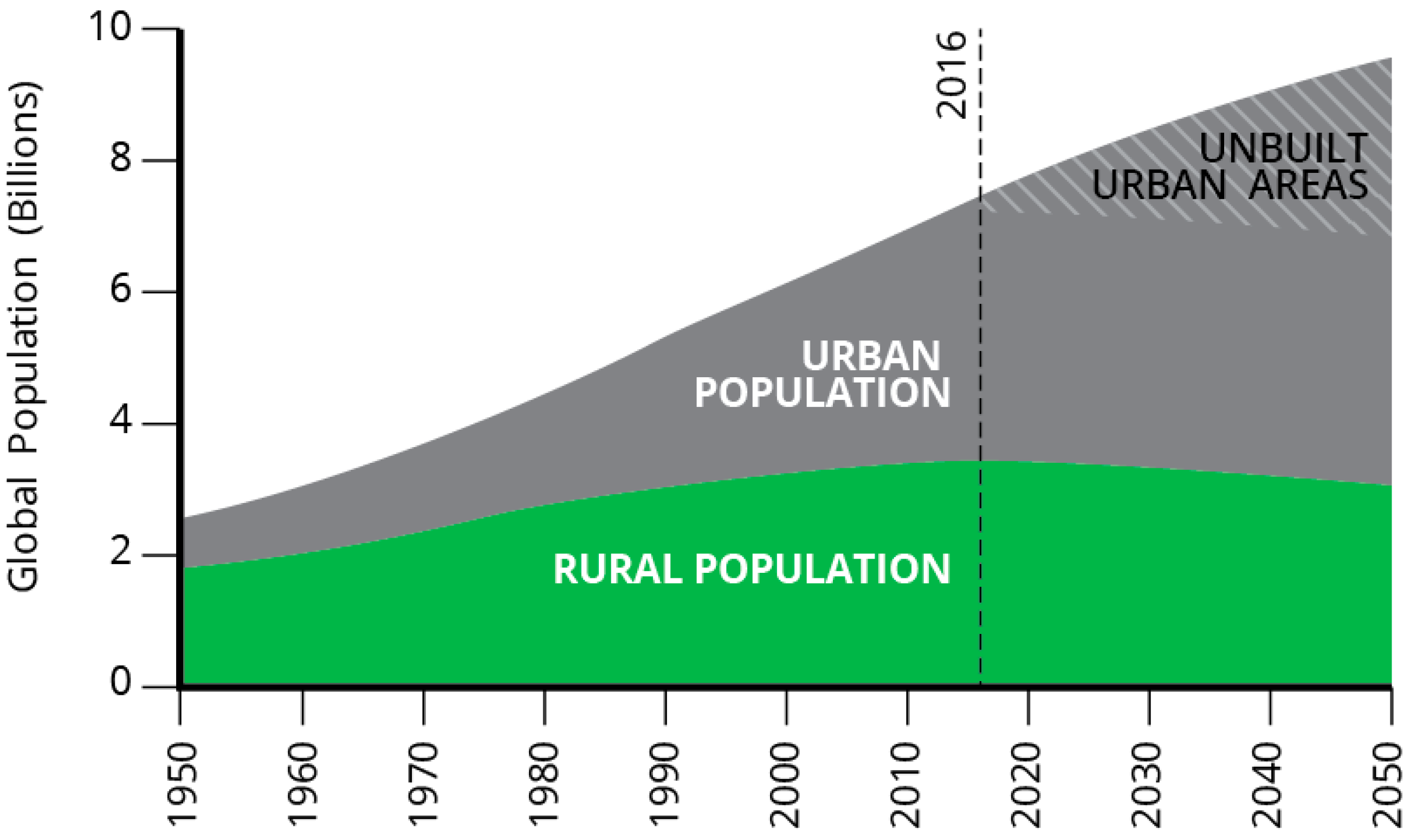
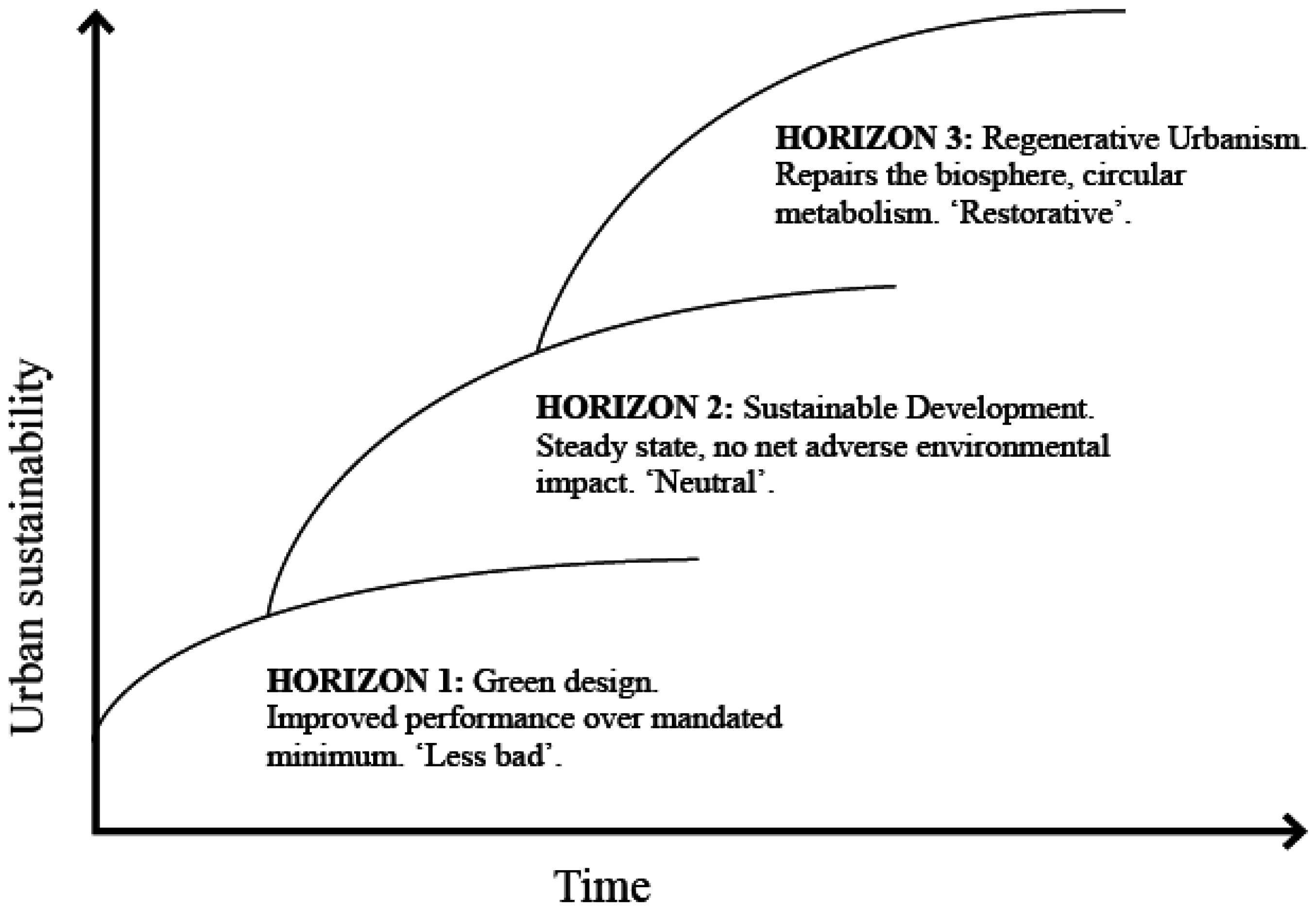
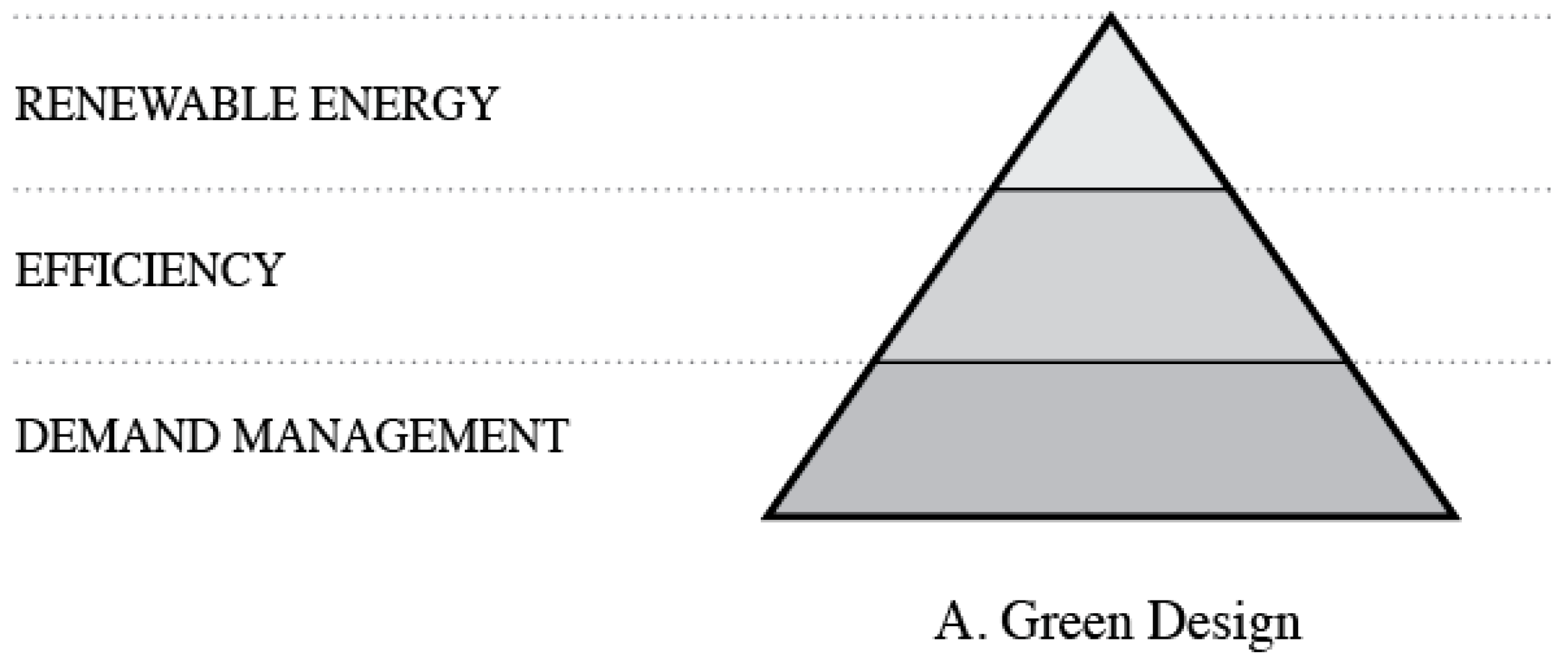

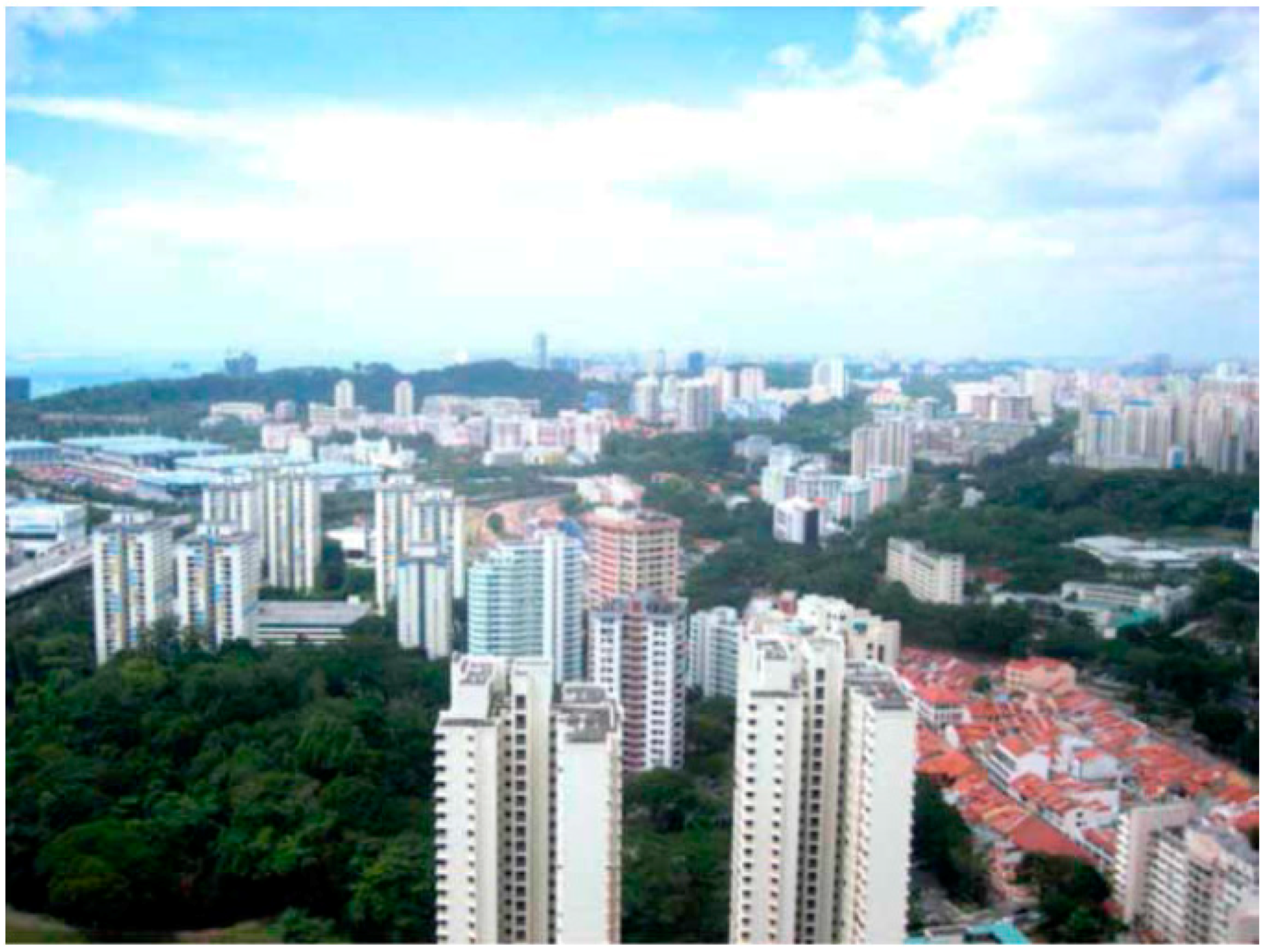
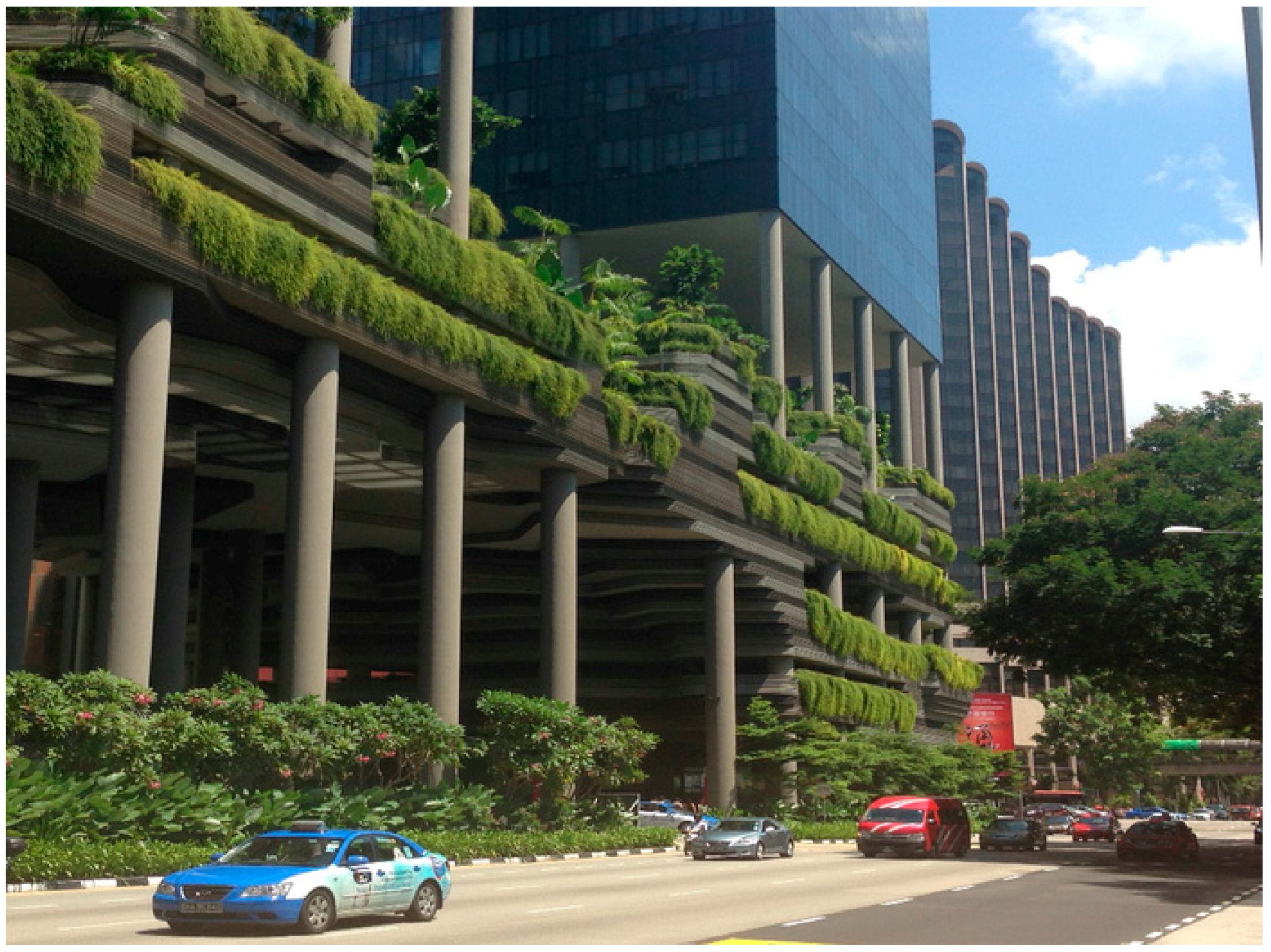
© 2016 by the authors; licensee MDPI, Basel, Switzerland. This article is an open access article distributed under the terms and conditions of the Creative Commons Attribution (CC-BY) license (http://creativecommons.org/licenses/by/4.0/).
Share and Cite
Thomson, G.; Newman, P. Geoengineering in the Anthropocene through Regenerative Urbanism. Geosciences 2016, 6, 46. https://doi.org/10.3390/geosciences6040046
Thomson G, Newman P. Geoengineering in the Anthropocene through Regenerative Urbanism. Geosciences. 2016; 6(4):46. https://doi.org/10.3390/geosciences6040046
Chicago/Turabian StyleThomson, Giles, and Peter Newman. 2016. "Geoengineering in the Anthropocene through Regenerative Urbanism" Geosciences 6, no. 4: 46. https://doi.org/10.3390/geosciences6040046





